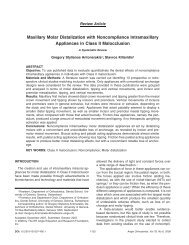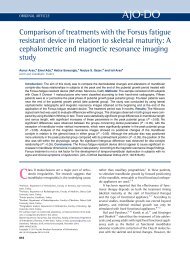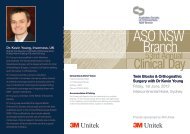As
Efficiency of a skeletonized distal jet appliance supported by ...
Efficiency of a skeletonized distal jet appliance supported by ...
You also want an ePaper? Increase the reach of your titles
YUMPU automatically turns print PDFs into web optimized ePapers that Google loves.
American Journal of Orthodontics and Dentofacial Orthopedics Kinzinger et al 581<br />
Volume 136, Number 4<br />
6. S-Go:N-Me: the facial height ratio (posterior face<br />
height to anterior face height).<br />
7. U1-CEJ/PTV: the distance from the maxillary<br />
central incisor to the pterygoid vertical.<br />
8. U4-CEJ/PTV: the distance from the maxillary first<br />
premolar to the pterygoid vertical.<br />
9. U5-CEJ/PTV, the distance from the maxillary second<br />
premolar to the pterygoid vertical.<br />
10. U6-CEJ/PTV: the distance from the maxillary first<br />
molar to the pterygoid vertical.<br />
11. U1/ANS-PNS: the angle between the maxillary<br />
central incisor and the palatal plane.<br />
12. U1/SN: the angle between the maxillary central<br />
incisor and the anterior cranial base.<br />
13. U4/ANS-PNS: the angle between the maxillary<br />
first premolar and the palatal plane.<br />
14. U4/SN: the angle between the maxillary first premolar<br />
and the anterior cranial base.<br />
15. U5/ANS-PNS: the angle between the maxillary<br />
second premolar and the palatal plane.<br />
16. U5/SN: the angle between the maxillary second<br />
premolar and the anterior cranial base.<br />
17. U6/ANS-PNS: the angle between the maxillary<br />
first molar and the palatal plane.<br />
18. U6/SN: the angle between the maxillary first<br />
molar and the anterior cranial base.<br />
19. U1-CEJ/ANS-PNS: the distance from the maxillary<br />
central incisor to the palatal plane.<br />
20. U4-CEJ/ANS-PNS, the distance from the maxillary<br />
first premolar to the palatal plane.<br />
21. U5-CEJ/ANS-PNS: the distance from the maxillary<br />
second premolar to the palatal plane.<br />
22. U6-CEJ/ANS-PNS: the distance from the maxillary<br />
first molar to the palatal plane.<br />
SNA, SNB, S-N/ANS-PNS, ANS-PNS/Go-Me,<br />
Björk’s summation angle, and the facial height ratio<br />
were measured or computed to verify any skeletal<br />
changes.<br />
In the sagittal plane, the relative incisor and first premolar<br />
mesial movement, hence the anchorage loss, and<br />
the relative second premolar and first molar distal movement<br />
in relation to the pterygoid vertical (U1-CEJ/PTV,<br />
U4-CEJ/PTV, U5-CEJ/PTV, and U6-CEJ/PTV) were<br />
determined. The respective points of reference for the<br />
measurements were the cementoenamel junction<br />
(CEJ) on the longitudinal axis of the teeth. Growthinduced<br />
changes (increase of 1 mm per year) were taken<br />
into account.<br />
The amounts of labial tipping of the incisors and<br />
first premolars and distal tipping of the second premolars<br />
and first molars were determined based on the<br />
angles between the longitudinal tooth axis and, respectively,<br />
the palatal plane or the anterior cranial base (U1/<br />
ANS-PNS, U1/SN; U4/ANS-PNS, U4/SN; U5/ANS-<br />
PNS, U5/SN; U6/ANS-PNS, U6/SN).<br />
Potential tooth intrusions and extrusions were verified<br />
in the palatal plane (U1-CEJ/ANS-PNS, U4-CEJ/<br />
ANS-PNS, U5-CEJ/ANS-PNS, and U6-CEJ/ANS-<br />
PNS).<br />
Statistical analysis<br />
Statistical computations were performed with SPSS<br />
software (version 14, SPSS, Chicago, Ill). Casts and lateral<br />
cephalographs were traced twice at a 4-week interval.<br />
If values deviated, the means of both measurements<br />
were fed into the statistical analysis. Then the arithmetic<br />
mean and the standard deviation were computed for every<br />
variable used in the in-vivo measurements, and the<br />
changes of each variable from T1 to T2 were statistically<br />
analyzed with a 1-sample t test. Thereby, we determined<br />
which effective changes were therapeutically<br />
induced by the treatment as evidence against the null<br />
hypothesis. Differences with a probability of error less<br />
than 5% (P \0.05) were considered statistically significant.<br />
RESULTS<br />
Metrical assessment of the maxilla casts before and<br />
after molar distalization with a skeletonized distal jet<br />
appliance showed the following dental position changes<br />
of the permanent first molars (Table I).<br />
The supporting zones increased by 4.01 6 0.63 mm<br />
in the first quadrant and 3.64 6 0.69 mm in the second<br />
quadrant. The transverse widths of the dental arch increased<br />
by means of 1.79 6 1.08 mm between the mesiobuccal<br />
cusps, 2.58 6 0.69 mm between the central<br />
fossae, and 3.03 6 0.68 mm between the distobuccal<br />
cusps; this indicates both expansion and mesial inward<br />
rotation of the permanent first molars. When we looked<br />
more closely, the permanent first molars of the first<br />
quadrant had rotated mesiopalatally and distobuccally<br />
by a mean 8.35 6 7.66 and those of the second quadrant,<br />
by 7.88 6 5.50 . All position changes of the<br />
permanent first molars were significant.<br />
Skeletal assessments showed that the cranial base<br />
remained constant, with changes of the SNA angle of<br />
only a mean 0.19 6 0.80 and the SNB angle of only<br />
a mean 0.13 6 0.82 . The positional relationships of<br />
the palatal plane to the anterior cranial base and to the<br />
mandibular plane were virtually unchanged. Björk’s<br />
summation angle changed by only 0.73 6 1.26 during<br />
molar distalization, and the facial height ratio changed<br />
by 0.58% 6 1.51%. All registered skeletal changes<br />
during treatment were not significant (Table II).






